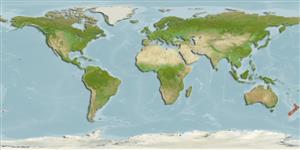>
Gobiesociformes (Clingfishes) >
Gobiesocidae (Clingfishes and singleslits) > Trachelochisminae
Etymology: Trachelochismus: Greek, trachelos = neck + Greek, schismos, -ou = cut (Ref. 45335).
Environment: milieu / climate zone / depth range / distribution range
Ecología
marino demersal; rango de profundidad 0 - 70 m (Ref. 116173). Temperate
Distribución
Países | Áreas FAO | Ecosistemas | Ocurrencias, apariciones | Point map | Introducciones | Faunafri
Southwest Pacific: endemic to New Zealand.
Tamaño / Peso / Age
Maturity: Lm ? range ? - ? cm
Max length : 5.0 cm TL macho / no sexado; (Ref. 9003); edad máxima reportada: 4 años (Ref. 9003)
Short description
Morfología | Morfometría
Espinas dorsales (total): 0; Radios blandos dorsales (total): 9-11; Espinas anales 0; Radios blandos anales: 7 - 8. Rose-pink in color, becoming scarlet on tail and fins. Pink with yellowish tinges ventrally. Deep reddish patch over most of body dorsally. Distinguished from other clingfishes by a broad, bluntly pointed head, with a thick, fleshy upper lip, no longitudinal groove below the eye but a line of papillae is usually present. The sucking disc has flattened papillae continuous across the anterior margin.
Inhabits sheltered areas beneath rocks of the intertidal at mid to low tide level. Also found in subtidal areas. Feeds on small crustaceans and mollusks.
Life cycle and mating behavior
Madurez | Reproducción | Puesta | Huevos | Fecundidad | Larva
Paulin, C. and C. Roberts, 1992. The rockpool fishes of New Zealand (Te ika aaria o Aotearoa). Museum of New Zealand (Te Papa Tongarewa). 177 p. (Ref. 9003)
IUCN Red List Status (Ref. 130435)
Threat to humans
Harmless
Human uses
Más información
Age/SizeCrecimientoLength-weightLength-lengthLength-frequenciesMorfometríaMorfologíaLarvaDinámica larvariaReclutamientoAbundanciaBRUVS
ReferenciasAcuiculturaPerfil de acuiculturaRazasGenéticaElectrophoresesheritabilidadEnfermedadesProcesamientoNutrientsMass conversion
ColaboradoresImágenesStamps, Coins Misc.SonidosCiguateraVelocidadTipo de nataciónSuperficie branquialOtolitosCerebrosVisión
Herramientas
Special reports
Download XML
Fuentes de Internet
Estimates based on models
Preferred temperature (Ref.
123201): 9.7 - 17.6, mean 13.1 °C (based on 103 cells).
Phylogenetic diversity index (Ref.
82804): PD
50 = 0.7500 [Uniqueness, from 0.5 = low to 2.0 = high].
Bayesian length-weight: a=0.00468 (0.00180 - 0.01212), b=3.12 (2.89 - 3.35), in cm total length, based on LWR estimates for this (Sub)family-body shape (Ref.
93245).
Nivel trófico (Ref.
69278): 3.3 ±0.0 se; based on diet studies.
Resiliencia (Ref.
120179): Medio, población duplicada en un tiempo mínimo de 1.4-4.4 años (tmax=4).
Fishing Vulnerability (Ref.
59153): Low vulnerability (10 of 100).
Nutrients (Ref.
124155): Calcium = 152 [78, 366] mg/100g; Iron = 0.518 [0.291, 1.042] mg/100g; Protein = 16.9 [15.7, 18.1] %; Omega3 = 0.571 [0.269, 1.224] g/100g; Selenium = 6.88 [2.65, 16.92] μg/100g; VitaminA = 53.5 [12.5, 221.6] μg/100g; Zinc = 1.17 [0.74, 1.76] mg/100g (wet weight);
